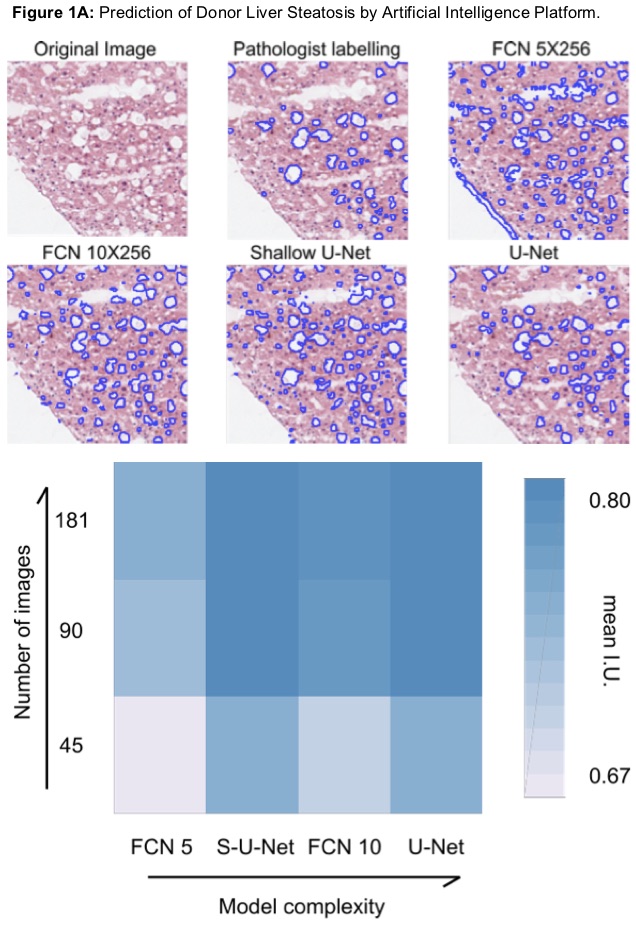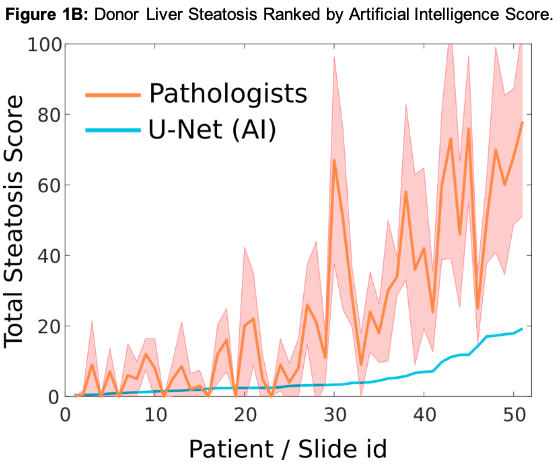Artificial Intelligence May Detect Donor Liver Steatosis and Predict Early Post-Transplantation Graft Failure
Stanford University, Stanford, CA
Meeting: 2020 American Transplant Congress
Abstract number: 070
Keywords: Donors, Graft failure, Graft function, Liver grafts, marginal
Session Information
Session Name: Deceased Donor Intervention and Management Research
Session Type: Oral Abstract Session
Date: Saturday, May 30, 2020
Session Time: 3:15pm-4:45pm
 Presentation Time: 3:39pm-3:51pm
Presentation Time: 3:39pm-3:51pm
Location: Virtual
*Purpose: To compare the accuracy of donor liver biopsy slides scored by manual histopathologic review versus a computer vision artificial intelligence (CVAI) platform to predict the degree of hepatic steatosis and early post-transplantation outcomes.
*Methods: Digitized H&E-stained slides prepared from donor liver biopsies performed between 2014-2017 were annotated to label fat globules by consensus of three independent pathologists. These files then trained four distinct convolutional neural networks operating at varying degrees of complexity (U-Net, “shallow” U-Net, FCN 5X256, and FCN 10X256) to quantify donor liver steatosis. To probe how the volume of training data affects the platform performance, three separate datasets with all, half, and a quarter of image tiles with dimension 256X256 pixels trained each of the aforementioned networks. A 90/10 training and validation split of images was used to train the CVAI platforms. Grade of steatosis (area of fat globules/total area of biopsied tissue) was categorized as minimal (<5%), mild (5-33%), moderate (33-66%), and severe (>66%). Early Graft Failure (EGF) was defined as markedly elevated liver function tests within a week of transplantation.
*Results: Of 69 identified donor liver biopsies, 8 slides were used to generate 191 training images. The U-Net models consistently obtained higher mean Intersection-over-Union (0.760) and validation classification accuracy (94.7%) compared to the other platforms (Figure 1A). Compared to the U-Net platform, slides reviewed by pathologists had higher steatosis scores (Figure 1B). When EGF occurred (7%), both manual histopathologic review and CVAI risk-stratified with 100% agreement.
*Conclusions: The CVAI platform demonstrated high accuracy and strong predictive metrics potentially capable of automating quantification of steatosis and preoperative prediction of EGF risk. The link between steatosis and graft outcomes may need to be recalibrated using newer, objective techniques. Verifying these findings in larger datasets with discarded grafts and platforms that include more histopathologic changes will aid in standardizing a more objective process for donor liver appraisal.
To cite this abstract in AMA style:
Narayan RR, Yang L, Abadilla N, Chen SB, Higgins JP, Melcher ML. Artificial Intelligence May Detect Donor Liver Steatosis and Predict Early Post-Transplantation Graft Failure [abstract]. Am J Transplant. 2020; 20 (suppl 3). https://atcmeetingabstracts.com/abstract/artificial-intelligence-may-detect-donor-liver-steatosis-and-predict-early-post-transplantation-graft-failure/. Accessed December 26, 2025.« Back to 2020 American Transplant Congress


